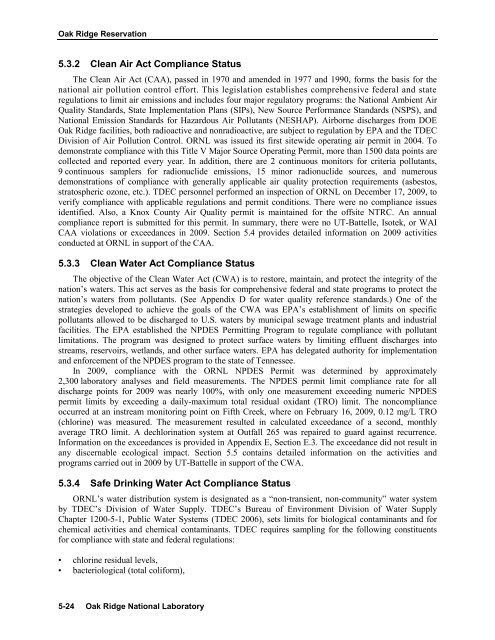DOE/ORO/2327 Oak Ridge Reservation Annual Site Environmental ...
DOE/ORO/2327 Oak Ridge Reservation Annual Site Environmental ...
DOE/ORO/2327 Oak Ridge Reservation Annual Site Environmental ...
You also want an ePaper? Increase the reach of your titles
YUMPU automatically turns print PDFs into web optimized ePapers that Google loves.
<strong>Oak</strong> <strong>Ridge</strong> <strong>Reservation</strong><br />
5.3.2 Clean Air Act Compliance Status<br />
The Clean Air Act (CAA), passed in 1970 and amended in 1977 and 1990, forms the basis for the<br />
national air pollution control effort. This legislation establishes comprehensive federal and state<br />
regulations to limit air emissions and includes four major regulatory programs: the National Ambient Air<br />
Quality Standards, State Implementation Plans (SIPs), New Source Performance Standards (NSPS), and<br />
National Emission Standards for Hazardous Air Pollutants (NESHAP). Airborne discharges from <strong>DOE</strong><br />
<strong>Oak</strong> <strong>Ridge</strong> facilities, both radioactive and nonradioactive, are subject to regulation by EPA and the TDEC<br />
Division of Air Pollution Control. ORNL was issued its first sitewide operating air permit in 2004. To<br />
demonstrate compliance with this Title V Major Source Operating Permit, more than 1500 data points are<br />
collected and reported every year. In addition, there are 2 continuous monitors for criteria pollutants,<br />
9 continuous samplers for radionuclide emissions, 15 minor radionuclide sources, and numerous<br />
demonstrations of compliance with generally applicable air quality protection requirements (asbestos,<br />
stratospheric ozone, etc.). TDEC personnel performed an inspection of ORNL on December 17, 2009, to<br />
verify compliance with applicable regulations and permit conditions. There were no compliance issues<br />
identified. Also, a Knox County Air Quality permit is maintained for the offsite NTRC. An annual<br />
compliance report is submitted for this permit. In summary, there were no UT-Battelle, Isotek, or WAI<br />
CAA violations or exceedances in 2009. Section 5.4 provides detailed information on 2009 activities<br />
conducted at ORNL in support of the CAA.<br />
5.3.3 Clean Water Act Compliance Status<br />
The objective of the Clean Water Act (CWA) is to restore, maintain, and protect the integrity of the<br />
nation’s waters. This act serves as the basis for comprehensive federal and state programs to protect the<br />
nation’s waters from pollutants. (See Appendix D for water quality reference standards.) One of the<br />
strategies developed to achieve the goals of the CWA was EPA’s establishment of limits on specific<br />
pollutants allowed to be discharged to U.S. waters by municipal sewage treatment plants and industrial<br />
facilities. The EPA established the NPDES Permitting Program to regulate compliance with pollutant<br />
limitations. The program was designed to protect surface waters by limiting effluent discharges into<br />
streams, reservoirs, wetlands, and other surface waters. EPA has delegated authority for implementation<br />
and enforcement of the NPDES program to the state of Tennessee.<br />
In 2009, compliance with the ORNL NPDES Permit was determined by approximately<br />
2,300 laboratory analyses and field measurements. The NPDES permit limit compliance rate for all<br />
discharge points for 2009 was nearly 100%, with only one measurement exceeding numeric NPDES<br />
permit limits by exceeding a daily-maximum total residual oxidant (TRO) limit. The noncompliance<br />
occurred at an instream monitoring point on Fifth Creek, where on February 16, 2009, 0.12 mg/L TRO<br />
(chlorine) was measured. The measurement resulted in calculated exceedance of a second, monthly<br />
average TRO limit. A dechlorination system at Outfall 265 was repaired to guard against recurrence.<br />
Information on the exceedances is provided in Appendix E, Section E.3. The exceedance did not result in<br />
any discernable ecological impact. Section 5.5 contains detailed information on the activities and<br />
programs carried out in 2009 by UT-Battelle in support of the CWA.<br />
5.3.4 Safe Drinking Water Act Compliance Status<br />
ORNL’s water distribution system is designated as a “non-transient, non-community” water system<br />
by TDEC’s Division of Water Supply. TDEC’s Bureau of Environment Division of Water Supply<br />
Chapter 1200-5-1, Public Water Systems (TDEC 2006), sets limits for biological contaminants and for<br />
chemical activities and chemical contaminants. TDEC requires sampling for the following constituents<br />
for compliance with state and federal regulations:<br />
• chlorine residual levels,<br />
• bacteriological (total coliform),<br />
5-24 <strong>Oak</strong> <strong>Ridge</strong> National Laboratory











